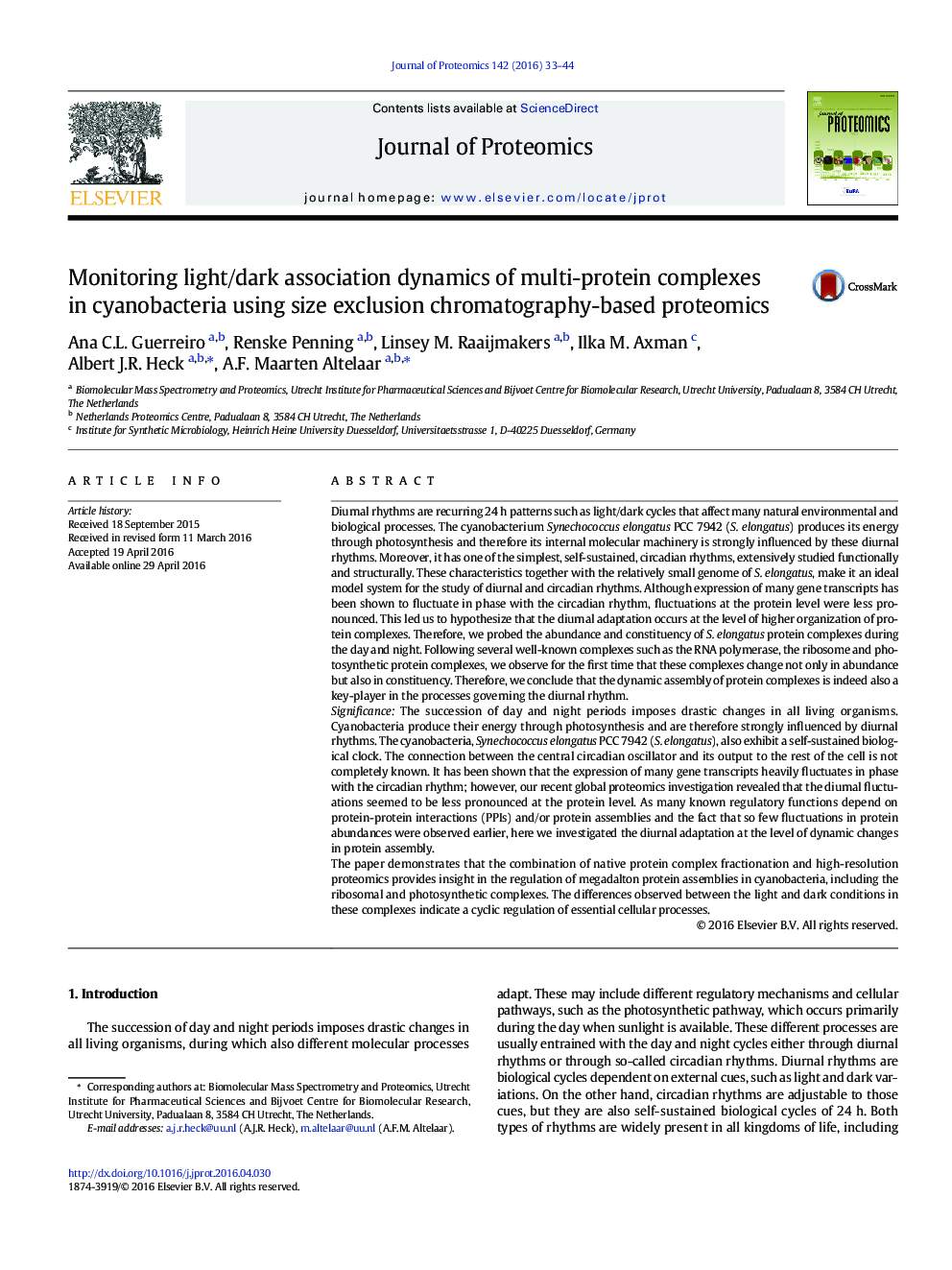| کد مقاله | کد نشریه | سال انتشار | مقاله انگلیسی | نسخه تمام متن |
|---|---|---|---|---|
| 1225194 | 1494739 | 2016 | 12 صفحه PDF | دانلود رایگان |
• First analysis of macromolecular assemblies in cyanobacteria in light/dark conditions
• We identify megadalton assemblies including ribosomal and photosynthetic complexes.
• We infer dynamic interactions for several protein complexes.
• Complexes involved in transcription and photosynthesis decrease during the dark.
• Observed differences indicate a cyclic regulation of essential cellular processes.
Diurnal rhythms are recurring 24 h patterns such as light/dark cycles that affect many natural environmental and biological processes. The cyanobacterium Synechococcus elongatus PCC 7942 (S. elongatus) produces its energy through photosynthesis and therefore its internal molecular machinery is strongly influenced by these diurnal rhythms. Moreover, it has one of the simplest, self-sustained, circadian rhythms, extensively studied functionally and structurally. These characteristics together with the relatively small genome of S. elongatus, make it an ideal model system for the study of diurnal and circadian rhythms. Although expression of many gene transcripts has been shown to fluctuate in phase with the circadian rhythm, fluctuations at the protein level were less pronounced. This led us to hypothesize that the diurnal adaptation occurs at the level of higher organization of protein complexes. Therefore, we probed the abundance and constituency of S. elongatus protein complexes during the day and night. Following several well-known complexes such as the RNA polymerase, the ribosome and photosynthetic protein complexes, we observe for the first time that these complexes change not only in abundance but also in constituency. Therefore, we conclude that the dynamic assembly of protein complexes is indeed also a key-player in the processes governing the diurnal rhythm.SignificanceThe succession of day and night periods imposes drastic changes in all living organisms. Cyanobacteria produce their energy through photosynthesis and are therefore strongly influenced by diurnal rhythms. The cyanobacteria, Synechococcus elongatus PCC 7942 (S. elongatus), also exhibit a self-sustained biological clock. The connection between the central circadian oscillator and its output to the rest of the cell is not completely known. It has been shown that the expression of many gene transcripts heavily fluctuates in phase with the circadian rhythm; however, our recent global proteomics investigation revealed that the diurnal fluctuations seemed to be less pronounced at the protein level. As many known regulatory functions depend on protein-protein interactions (PPIs) and/or protein assemblies and the fact that so few fluctuations in protein abundances were observed earlier, here we investigated the diurnal adaptation at the level of dynamic changes in protein assembly.The paper demonstrates that the combination of native protein complex fractionation and high-resolution proteomics provides insight in the regulation of megadalton protein assemblies in cyanobacteria, including the ribosomal and photosynthetic complexes. The differences observed between the light and dark conditions in these complexes indicate a cyclic regulation of essential cellular processes.
Figure optionsDownload high-quality image (138 K)Download as PowerPoint slide
Journal: Journal of Proteomics - Volume 142, 16 June 2016, Pages 33–44
